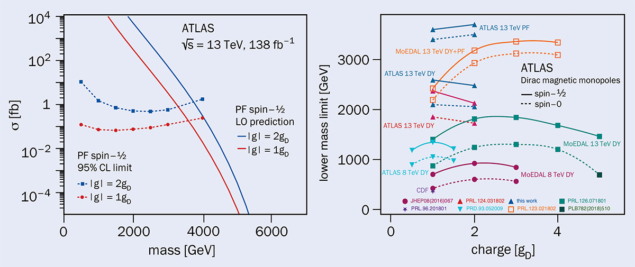A report from the ATLAS experiment.

Magnetic monopoles are hypothetical particles that possess a magnetic charge. In 1864 James Clerk Maxwell assumed that magnetic monopoles didn’t exist because no one had ever observed one. Hence, he did not incorporate the concept of magnetic charges in his unified theory of electricity and magnetism, despite their being fully consistent with classical electrodynamics. Interest in magnetic monopoles intensified in 1931 when Dirac showed that quantum mechanics can accommodate magnetic charges, g, allowed by the quantisation condition g = Ne⁄2α = NgD, where e is the elementary electric charge, α is the fine structure constant, gD is the fundamental magnetic charge and N is an integer. Grand unified theories predict very massive magnetic monopoles, but several recent extensions of the Standard Model feature monopoles in a mass range accessible at the LHC. Scientists have explored cosmic rays, particle collisions, polar volcanic rocks and lunar materials in their quest for magnetic monopoles, yet no experiment has found conclusive evidence thus far.
Signature strategy
The ATLAS collaboration recently reported the results of the search for magnetic monopoles using the full LHC Run 2 dataset recorded in 2015–2018. Magnetic charge conservation dictates that magnetic monopoles are stable and would be created in pairs of oppositely charged particles. Point-like magnetic monopoles could be produced in proton–proton collisions via two mechanisms: Drell–Yan, in which a virtual photon from the collision creates a magnetic monopole pair; or photon-fusion, whereby two virtual photons scattering off proton collisions interact to create a magnetic monopole pair. Dirac’s quantisation condition implies that a 1gD monopole would ionise matter in a similar way as a high-electric-charge object (HECO) of charge 68.5e. Hence, magnetic monopoles and HECOs are expected to be highly ionising. In contrast to the behaviour of electrically charged particles, however, the Lorentz force on a monopole in the solenoidal magnetic field encompassing the ATLAS inner tracking detector would cause it to be accelerated in the direction of the field rather than in the orthogonal plane – a trajectory that precludes the application of usual track-reconstruction methods. The ATLAS detection strategy therefore relies on characterising the highly ionising signature of magnetic monopoles and HECOs in the electromagnetic calorimeter and in the transition radiation tracker.
This is the first ATLAS analysis to consider the photon-fusion production mechanism
The ATLAS search considered magnetic monopoles of magnetic charge 1gD and 2gD, and HECOs of 20e, 40e, 60e, 80e and 100e of both spin-0 and spin-½ in the mass range 0.2–4 TeV. ATLAS is not sensitive to higher charge monopoles or HECOs because they stop before the calorimeter due to their higher ionisation. Since particles in the considered mass range are too heavy to produce significant electromagnetic showers in the calorimeter, their narrow high-energy deposits are readily distinguished from the broader lower-energy ones of electrons and photons. Events with multiple high-energy deposits in the transition radiation tracker aligned with a narrow high-energy deposit in the calorimeter are therefore characteristic of magnetic monopoles and HECOs.
Random combinations of rare processes, such as superpositions of high-energy electrons, could potentially mimic such a signature. Since such rare processes cannot be easily simulated, the background in the signal region is estimated to be 0.15 ± 0.04 (stat) ± 0.05 (syst) events through extrapolation from the lower ionisation event yields in the data.
With no magnetic monopole or HECO candidate observed in the analysed ATLAS data, upper cross-section limits and lower mass limits on these particles were set at 95% confidence level. The Drell–Yan cross-section limits are approximately a factor of three better than those from the previous search using the 2015–2016 Run 2 data.
This is the first ATLAS analysis to consider the photon-fusion production mechanism, the results of which are shown in figure 1 (left) for spin-½ monopoles. ATLAS is also currently the most sensitive experiment to magnetic monopoles in the charge range 1-2gD, as shown in figure 1 (right), and to HECOs in the charge range of 20–100e. The collaboration is further refining search techniques and developing new strategies to search for magnetic monopoles and HECOs in both Run 2 and Run 3 data.
Further reading
ATLAS Collab. 2023 JHEP 11 112.







